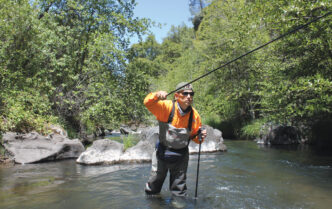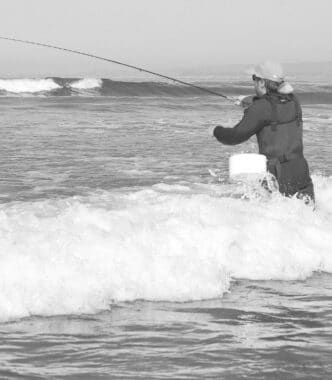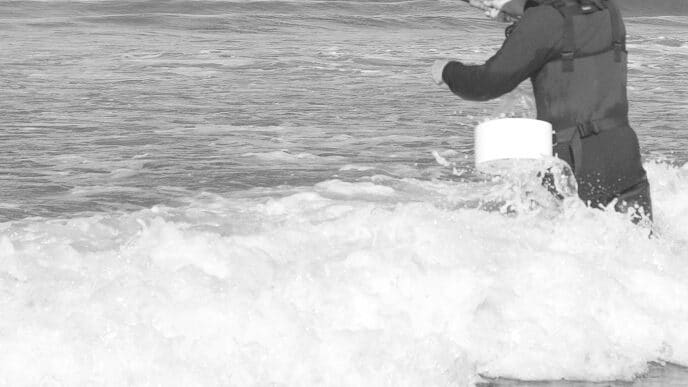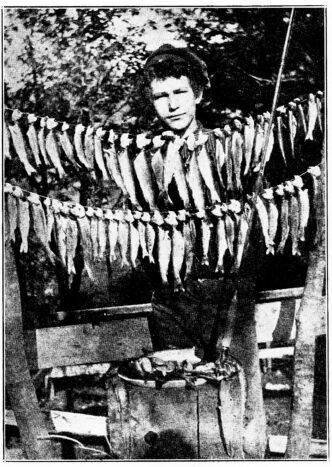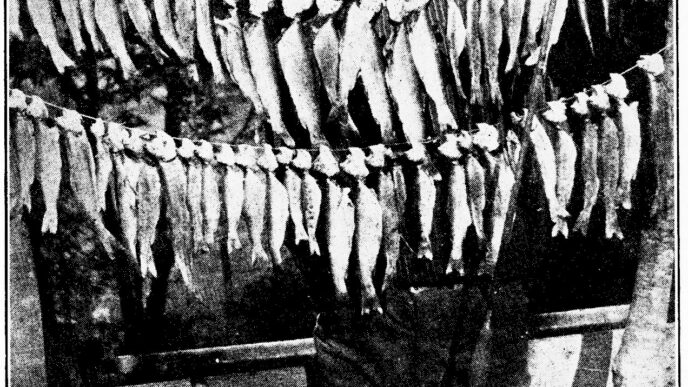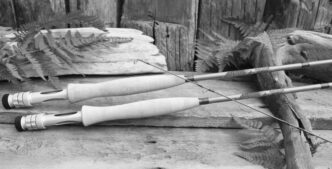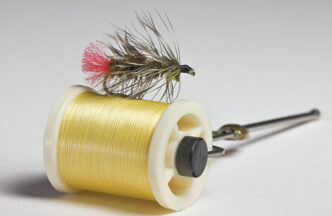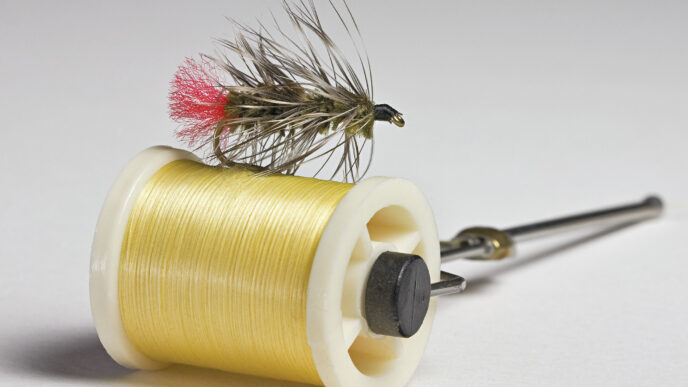This time of year, the comment most often heard among fly rodders goes something like this:
“The weather is hot, and the fishing has cooled off.” Of course, as a counterbalance, we also hear the saying, “The worst day of fishing is better than the best day of work.” With those two thoughts in mind, plotting a course of action is fairly simple if you fish for trout. After all, summer brings access to the high mountain lakes and streams that froze or closed at the end of autumn. For warmwater anglers, however, the set of choices is a little less clear. Most of California, at least the bass fishing part of it, swelters under the full weight of summer’s intense heat.
My first recommendation to bass fly rodders who seek a place to fish is to head for the higher elevations in your area and prospect for bass on lakes that fall between true trout-only waters and lower-elevation bass lakes. What you want is a lake or pond that is known to hold bass and where, due to the cooler nights that occur at altitude, water temperatures during summer fall within the 60-to-70-degree range that both bass and trout find relatively comfortable. If you look around your part of California, you will likely come across a number of lakes that meet those requirements. (See the sidebar for several lakes in Southern California that fish well during the doldrums of summer.) Preferred altitudes tend to range from around 3,000 feet up to perhaps 7,000 feet.
Note, however, that this suggestion works best for fly rodders who have lots of spare time, but what about those of us who for one reason or another can’t get up into the mountains to take advantage of the cooler summer temperatures there? I would tell those people to fish early or late in the day, and even to fish for bass at night when they can.
Rising early from bed and hitting your favorite bass water is a time-tested approach to fishing. In the early spring — say in late February or into March — bass often seek a little sunshine. They’ll frequently be found in water that’s just one or two degrees warmer than the rest of the lake, and probably along the north side, as well, because it receives heat from the low sun all day long. The fishing usually gets underway by mid-morning.
In July or August, however, most of the decent fly fishing for bass is over by mid-morning. You want to be on the water when the sky is light, but the sun is still below the horizon. The bass under these conditions have been night feeding and will remain in the shallows only as long as they have shade. Once the summer sun shines on the surface, the fish will retreat into deeper water or seek overhead cover, such as a drowned tree or lily pads, to beat the heat and gain a sense of security.
You can get in an hour of two of pretty decent fishing at dawn. If you pick your location so that you obtain the advantage of any shade that hits the water from the east, you will have more time to hope that a big bass will eat your fly. Once the sun has fully fallen on the water and the day is finally well underway, however, switch from a floating bass bug to a sinking line and a subsurface pattern that will descend several feet. You can fish all day, even during summer, but the angling is seldom as rewarding as during the first and last hours of daylight. Of the two, I much prefer the last hour of twilight in the evening over the first hour in the morning, but that’s mostly because I don’t like to get up that early.
The fishing can be better in the evening, too. During the last couple of hours of daylight, the bass haven’t had access to the prolific amount of food to be found in the shallower areas of the lake. They have been in deeper water most of the day, and while they’ve taken advantage of any hapless critter that swam by their deepwater haunts, they’re hungry. That means the onset of feeding in the evening may be more exciting to fish than the last bit of night feeding you get in the early morning, when the bass are just snacking before retiring to the cooler depths.
Approach this later period of summer bass fishing in reverse from the morning’s tactics. If I fish the afternoon-evening bite, I generally start while the sun is still above the horizon with a sinking line and something that resembles a plastic worm tied out of rabbit fur. This is a good daylight pattern to fish, and I don’t switch to a floating line and a bass bug until there is shade on the water. Also, I mostly target the west side of the lake, where the shade falls first in the late afternoon and evening. Sometimes I don’t switch to the surface fly until I’ve seen at least a few swirls that indicate bass are taking prey off the surface, or at least close to it. Mostly, though, I switch as the shadows reach out across the water from the western shore, giving the bass the comfort and concealment they want. It’s a lot more fun to fish a surface fly or bug than it is to plumb the unseen depths with a sinking line.
I would also tell most bass anglers who take up the fly rod that they are fishing too fast. You can beat the heck out of the water with plastic worms or even with a spinnerbait and conventional tackle, but once you pick up a fly rod and start fishing bass bugs on the surface, you’d better slow down. The hectic pace exhibited by most pro bass anglers is fine for maximizing catch rates, but when fishing topwater with a fly rod, a slower, stealthier approach will get you bigger fish. Also, frantic retrieves often put the fish off. They’ve been lurking in the depths all day and are not used to having a lot of commotion going on right over their heads.
For that reason alone, the so-called “do nothing” retrieve, in which you cast the bug to a likely looking bit of shadowed cover and just allow it to sit quietly until the last ripples of its landing have faded away before giving it a small twitch, is one of the most effective retrieves you can use with a bug. It doesn’t scare the fish. You may not get a strike with the bug just sitting there, but you haven’t spooked every fish within a dozen yards. If you let your fly remain motionless for perhaps 30 seconds — if you can stand it — you may well be rewarded with a bass.
Pay close attention to your bug, however. Although you could get a smashing strike that looks and sounds like someone dropped a cannonball into the lake, if you are watching, you could also just see your bass bug disappear in a gentle rise that barely ripples the water. It could be that your bass bug was sucked under by a bluegill or some other panfish, but that gentle rise could also be a take by the biggest bass in the lake.
Of course, the best solution to the daytime heat is to avoid it entirely. Forget fishing in either the morning or the evening, stay home or work during the day, and venture out only to fish the night hours. It works, and isn’t nearly as dangerous as you might first suspect. You need to locate a lake where you can fish at night legally, then you need to learn the local topography. You must have a good mental image of the area you are going to fish. Once it’s dark, everything looks strange, and if you don’t know where you are, you could easily get hurt.
I won’t attempt to night fish on a lake I don’t know well. Decades ago, before it was developed into a fancy county park, a bunch of us used to night fish at Puddingstone Reservoir, near the Pomona Fairgrounds. We’d park over by the tower at Brackett Airport, hop the fence between the airport property and the reservoir, and follow a well-worn trail down to the edge of the undeveloped lake. The fishing, as I recall, was pretty good, and we had the whole layout pretty well memorized.
Memorizing the layout is the key. You don’t want to be shining a light all over the place when walking to the water, because doing so will usually end up spooking fish. Make all the noise you want and it won’t startle your quarry, but a momentary flash of light will.
Be aware of wildlife and large critters. You won’t forget the first rattlesnake you hear buzzing away in the dark. The best protection if you’re fishing in snake country is a pair of leather boots with high tops. Over the years, I’ve run into a number of living things that scared me until I either located where the sound was coming from or figured out what was causing it. I’ve never been stalked by anything — that I know of — but I’ve been startled by coyotes, a bear, and range cattle while night fishing. You can still find some interesting and rewarding angling during the worst part of the summer. Go higher into the mountains, if you can. If not, fish early and late, or at night. The fishing during the hours when the sun is not beating down on your head won’t perhaps be as good as angling during the spring, but then again, it isn’t as bad as not fishing at all.
Southern California Lakes for the Doldrums
In my part of Southern California, four destinations come quickly to mind for fly rodders seeking lakes at altitudes between 3,000 feet and 7,000 feet where they can beat the heat and hook a few fish. One is Lake Hemet, up on Mount San Jacinto. This modestly-sized 420-surface-acre reservoir serves as the head of the San Jacinto River and is managed both for recreation and as a source of irrigation water. It gets stocked with trout nearly year-round, but has healthy panfish and bass populations, as well. At an elevation of 4,500 feet, Hemet is an excellent summer getaway for anglers who like fishing for both trout and warmwater species.
Lake Gregory is about a third the size of Lake Hemet. It’s a county park lake located in the mountain resort of the same name, and offers very good summer trout action (thanks to weekly stocks of trout), and action, too, for bass and other warmwater species. It also has one attraction for fly fishers that Hemet lacks: you can launch your float tube at Lake Gregory, which is a big advantage when prospecting for midsummer bass. Its altitude is almost identical to Lake Hemet’s.
Another SoCal water that fills an important summertime role for bass fly rodders is Big Bear Lake. Located in the San Bernardino National Forest, Big Bear is much larger than Hemet — more than 3,000 surface acres — and is at higher altitude at 6,750 feet. It has plenty of largemouth bass (and trout), but the success rate on smallmouths also shot up markedly this spring. Apparently the smallmouths are finding the current season to their liking.
Farther to the north is the even larger Lake Isabella in Kern County. Situated in the foothills of the southern Sierra’s west slope, Isabella is huge, with a great bass population and thousands of acres of water to fish. It also is at a medium altitude, which means you get to angle for trout and panfish, too.
Richard Alden Bean






